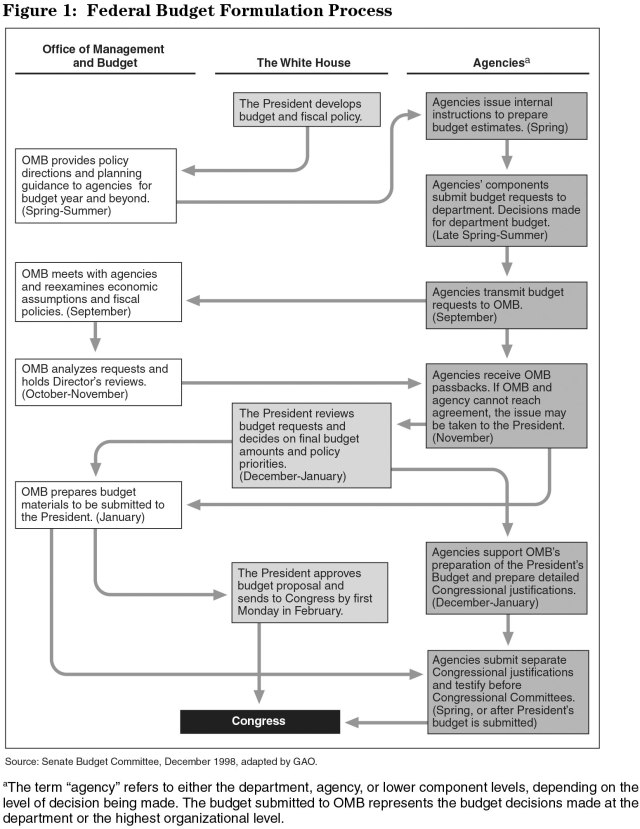Budget Day Is Around the Corner
The 2017 President’s Budget is scheduled to be released next week.
The president’s proposal is the result of work that started last spring at the White House, the Office of Management and Budget, and executive branch agencies—from Agriculture to Veterans Affairs.
We've already highlighted how to navigate the complexities of the federal budget and peeked at the future of the federal budget. Today, we focus on the 4 phases of the annual budget cycle.
(Excerpted from GAO-05-734SP)[/caption]
Phase 1: Budget Preparation and Review
The budget cycle starts in the executive branch, as OMB and the president continually exchange information about spending and priorities. Agencies also review their current operations, program objectives, and future plans to determine their budget requests. OMB then consolidates all of the agencies’ budget requests into one.
The president submits this consolidated budget request, called the “The President’s Budget,” to Congress in early February for the next fiscal year. For example, the budget submitted next week is for fiscal year 2017, which starts October 2016 and runs through September 2017.
Phase 2: Congressional Action
Next, Congress reviews the president’s proposal.
Congress has the authority to approve the funding in the president’s budget request, increase or decrease funding, eliminate proposals, or add programs that the administration has not requested.
Congress has a two-pronged approach to its budget review. The House and Senate budget committees pass a resolution that sets annual fiscal policy targets—goals for how much the federal government will spend in each major category, such as defense. The House and Senate appropriations committees then set how much of that money federal agencies may actually spend.
The subcommittees within the appropriations committees hold hearings and draft bills for designated groupings of agencies and programs—for example, there are subcommittees that group together military construction and veterans affairs, among other things. These draft bills then move to the full committee and eventually both chambers of Congress.
Phase 3: Execution and Control
After Congress passes appropriations bills and enacts them in to law, Treasury and OMB distribute the budgeted amounts to the executive branch agencies to fund their programs.
Each federal agency is responsible for spending their money as directed by Congress in the budget and appropriations laws. We, along with agency inspectors general, audit and review agencies to make sure they’re spending their money appropriately.
Phase 4: Final Phase: Account Closing
Congress sets time limits on all appropriated funds. This means that agencies must put the money to use within a year, multiple years, or until the funds are fully spent. Once the time limit has passed, an agency can no longer use those funds to pay for new expenses, but the money remains available for 5 years to settle any prior obligations—like a late bill.
After 5 years, expired accounts are closed and the remaining balances are returned to the Treasury.
While this is the general process, there’s much more to it. Take a look at our Red Book for more information on the legal aspects of appropriations and the Budget Glossary for key federal budget terms.
- Questions on the content of this post? Contact Sue Irving at irvings@gao.gov, Michelle Sager at sagerm@gao.gov or Heather Krause at krauseh@gao.gov.
- Comments on GAO’s WatchBlog? Contact blog@gao.gov.
GAO Contacts
Related Products

GAO's mission is to provide Congress with fact-based, nonpartisan information that can help improve federal government performance and ensure accountability for the benefit of the American people. GAO launched its WatchBlog in January, 2014, as part of its continuing effort to reach its audiences—Congress and the American people—where they are currently looking for information.
The blog format allows GAO to provide a little more context about its work than it can offer on its other social media platforms. Posts will tie GAO work to current events and the news; show how GAO’s work is affecting agencies or legislation; highlight reports, testimonies, and issue areas where GAO does work; and provide information about GAO itself, among other things.
Please send any feedback on GAO's WatchBlog to blog@gao.gov.





